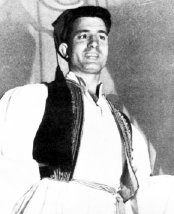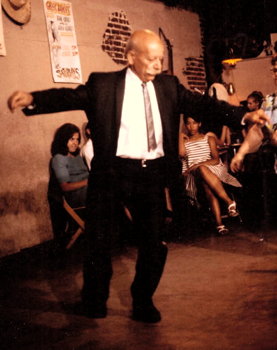
|
Folk Dance Federation of California, South, Inc.
The Individual |

|
 There are many and varied ways of dancing Greek dances so long as they are expressed within the conceived form and rhythm in which the typical Greek character is most clearly depicted. The individual dancer has a lot to do with shaping the dance and it is through the expert dancers that tradition and form are handed down. Being a good dancer he will always be true to the correct attitude to the dance but will also fill in the necessary gaps with his imagination and enthusiasm for Greek dance.
There are many and varied ways of dancing Greek dances so long as they are expressed within the conceived form and rhythm in which the typical Greek character is most clearly depicted. The individual dancer has a lot to do with shaping the dance and it is through the expert dancers that tradition and form are handed down. Being a good dancer he will always be true to the correct attitude to the dance but will also fill in the necessary gaps with his imagination and enthusiasm for Greek dance.
The leader in Greek dances appears to have greater freedom than other other folk dances. By freedom, I do not intend to imply that he can do as he pleases, but on the contrary, this leading dancer's imagination very often is responsible for the popularity of certain dances as well as of dance movements. The leader therefore has a manifold responsibility; he is not merely having an improvised lark.
In tracing briefly the historical evolution of the leader today in Greek folk dances, we have to go back to ancient Greece and observe certain trends. The early pre-dithyramb dance-songs were group dances without any significance to a leading dancer. Later they developed into the dithyrambic dance-songs in honor of Dionysos, the God of Wine, and a leader is mentioned leading a group of dancers. It was close to the Fifth Century when the democratic instinct bean to develop in the Greeks, and with the development of democracy the individual tries to find ways to express himself and his strife, and to find his relationship to the group. The leader of the group expresses himself in his own instinctive way of moving, which is very often unique. The leader leads the people to the dance in a circle and almost pulls the with force as in the ancient "syrtos," dragging them to join in common feeling of movement, to become one with the group and find an identity in the group, which is bigger than just an individual feeling. The leader therefore becomes the interpreter of the group's feelings, of their joy and exaltation. The group emotion is seen in the one person, the leader.
As we continue our study of Greek dance and its relationship to ancient forms, we see the leader extended in Greek tragedy, now called "korifeos" or leader. Thus the tragedy with its choruses (meaning dance) has kept the leader in the tragedies. As the plays developed and the korifeos, who in Greek tragedy interpreted mass emotion seen in an individual, so in the folk dances does the leader only exalt into bigger and more free movements because of his support from the group. In leading the dancers, he enhances, enriches, and excites them to the dance through movements. Therefore, he has the responsibility of injecting life into the dance, or the spirit that makes dancing both fun and exciting — the difference between marking a dance and dancing it. In the Greek villages the folk dance creates an attitude of life in the dancer, and very often is a strong contributing factor in his social standing in the community. The young man for instance will express his virility, prowess, strength, endurance, and physical agility, and also his poetic temperament of life. This is one way he competes in his society, for the young women will watch him closely and they will determine his his "levendia" (youthful gentle pride), and the future husband he will be. The young women will express their beauty, graceful movements, gentility, and sensitivity, in which the men seek to console their robust fervor. These are deep motives for dance, and why men dance the way they do.
These sociological motives together with the spiritual are the reasons men need to get away from the ordinary every-day movements. From these strong socially inbred motives man began to create an abstract world for himself, hoping to find the unconscious of his intense feelings. This motivates the release of his abstract world which cannot always be solved through rationalization, and becomes free. Freedom therefore would be one of the aims of the dance. Man must combat the burdens of responsibilities that face him in his lifetime, such as the struggle to live, the forces of nature, and the demands of his social roles. Since religion cares for a man's subjectivity, dancing has been closely connected with religion, as it still is in many primitive countries and as it was in ancient times. The greatest period of the most inspired dancing existed when dance was devoted to religion. Though dance and dancing, especially folk dance, are totally secular today, if closely examined, the high movements of a dancer in his dancing are very close to religious feeling. While the leader dances and as he strides with his group in a circle, they offer him their support, in the same way they would support a friend or a leader in everyday life. This demonstration of democratic faith in man shows the importance of the individual, and while being an individual he feels fully responsible for his people. During the course of the dance the circle can change leaders, the previous leader joining the group and offering his support together with the others in having elected another leader, certainly another very definite democratic demonstration. If there was always only one leader it would be a way of showing that there was absolute power.
There is also a competitive element in the dance and very often exhibited with dance leaders. There is a natural attempt to outdo each other. This element of competition exists in all levels of life, and since it has been accepted as a virtue that contributes to man's progress, there is no reason why it shouldn't exist in dance. The group in terms of the dance simply keeps time as the leader reenacts various expressive movements, outbursts of happiness, and at times the second dancer in the circle joins actively and dances with the leader. The last dancer of the open circle also may improvise, but here the comic element is usually depicted, since the intensity of the group needs some relaxation.
The steps of Greek dances have become traditional as they have passed from generation to generation. The form is almost always the same but new steps are introduced, especially by leading dancers. That seems to be the characteristic of a certain dancer, executing in a different way with a variety of styling, and is popularized until new favorites are introduced. This is also true of course when dancers are from different parts of Greece, since there are definite characteristics that are local. These characteristics differ to the degree of cultural isolation and the historical background of the region. So the leader of Greek folk dances today has great predominance, but he also had evolved to this position throughout the ages, and his position holds great significance for the Greek. Since Greeks to this day are known for their individuality, it would therefore make sense that their dances are rich with dance variations done by leaders, as compared with the simple basic steps done by the rest of the group, and anyone attempting to become familiar with Greek dances should therefore aim to become a leader as well as a follower.
Used with permission of the author.